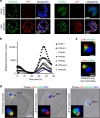A lipid-binding protein mediates rhoptry discharge and invasion in Plasmodium falciparum and Toxoplasma gondii parasites
- PMID: 31492901
- PMCID: PMC6731292
- DOI: 10.1038/s41467-019-11979-z
A lipid-binding protein mediates rhoptry discharge and invasion in Plasmodium falciparum and Toxoplasma gondii parasites
Abstract
Members of the Apicomplexa phylum, including Plasmodium and Toxoplasma, have two types of secretory organelles (micronemes and rhoptries) whose sequential release is essential for invasion and the intracellular lifestyle of these eukaryotes. During invasion, rhoptries inject an array of invasion and virulence factors into the cytoplasm of the host cell, but the molecular mechanism mediating rhoptry exocytosis is unknown. Here we identify a set of parasite specific proteins, termed rhoptry apical surface proteins (RASP) that cap the extremity of the rhoptry. Depletion of RASP2 results in loss of rhoptry secretion and completely blocks parasite invasion and therefore parasite proliferation in both Toxoplasma and Plasmodium. Recombinant RASP2 binds charged lipids and likely contributes to assembling the machinery that docks/primes the rhoptry to the plasma membrane prior to fusion. This study provides important mechanistic insight into a parasite specific exocytic pathway, essential for the establishment of infection.
Conflict of interest statement
The authors declare no competing interests.
Figures








Similar articles
-
Cryogenic electron tomography reveals novel structures in the apical complex of Plasmodium falciparum.mBio. 2024 Apr 10;15(4):e0286423. doi: 10.1128/mbio.02864-23. Epub 2024 Mar 8. mBio. 2024. PMID: 38456679 Free PMC article.
-
How Apicomplexa Parasites Secrete and Build Their Invasion Machinery.Annu Rev Microbiol. 2022 Sep 8;76:619-640. doi: 10.1146/annurev-micro-041320-021425. Epub 2022 Jun 7. Annu Rev Microbiol. 2022. PMID: 35671531 Review.
-
A Member of the Ferlin Calcium Sensor Family Is Essential for Toxoplasma gondii Rhoptry Secretion.mBio. 2018 Oct 2;9(5):e01510-18. doi: 10.1128/mBio.01510-18. mBio. 2018. PMID: 30279285 Free PMC article.
-
An apical membrane complex for triggering rhoptry exocytosis and invasion in Toxoplasma.EMBO J. 2022 Nov 17;41(22):e111158. doi: 10.15252/embj.2022111158. Epub 2022 Oct 17. EMBO J. 2022. PMID: 36245278 Free PMC article.
-
Biogenesis and discharge of the rhoptries: Key organelles for entry and hijack of host cells by the Apicomplexa.Mol Microbiol. 2021 Mar;115(3):453-465. doi: 10.1111/mmi.14674. Mol Microbiol. 2021. PMID: 33368727 Review.
Cited by
-
Toxoplasma Mechanisms for Delivery of Proteins and Uptake of Nutrients Across the Host-Pathogen Interface.Annu Rev Microbiol. 2020 Sep 8;74:567-586. doi: 10.1146/annurev-micro-011720-122318. Epub 2020 Jul 17. Annu Rev Microbiol. 2020. PMID: 32680452 Free PMC article. Review.
-
Functional Characterization of the Thrombospondin-Related Paralogous Proteins Rhoptry Discharge Factors 1 and 2 Unveils Phenotypic Plasticity in Toxoplasma gondii Rhoptry Exocytosis.Front Microbiol. 2022 Jun 9;13:899243. doi: 10.3389/fmicb.2022.899243. eCollection 2022. Front Microbiol. 2022. PMID: 35756016 Free PMC article.
-
PfCERLI1 is a conserved rhoptry associated protein essential for Plasmodium falciparum merozoite invasion of erythrocytes.Nat Commun. 2020 Mar 16;11(1):1411. doi: 10.1038/s41467-020-15127-w. Nat Commun. 2020. PMID: 32179747 Free PMC article.
-
In situ ultrastructures of two evolutionarily distant apicomplexan rhoptry secretion systems.Nat Commun. 2021 Aug 17;12(1):4983. doi: 10.1038/s41467-021-25309-9. Nat Commun. 2021. PMID: 34404783 Free PMC article.
-
An Alveolata secretory machinery adapted to parasite host cell invasion.Nat Microbiol. 2021 Apr;6(4):425-434. doi: 10.1038/s41564-020-00854-z. Epub 2021 Jan 25. Nat Microbiol. 2021. PMID: 33495622 Free PMC article.
References
-
- Carruthers VB, Sibley LD. Sequential protein secretion from three distinct organelles of Toxoplasma gondii accompanies invasion of human fibroblasts. Eur. J. Cell Biol. 1997;73:114–123. - PubMed
Publication types
MeSH terms
Substances
Grants and funding
LinkOut - more resources
Full Text Sources
Other Literature Sources
Miscellaneous

